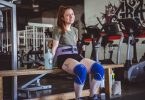For many of us, the idea of getting muscular without working out sounds too good to be true. After all, isn’t hitting the gym and lifting weights the only way to build muscle mass? Surprisingly, there are some who claim that it’s possible to get muscular without working out. But is there any truth to this claim, or is it just a myth?
In this article, we’ll explore the science behind muscle growth and the role that exercise plays in building muscle mass. We’ll also examine some of the alternative methods that have been proposed for building muscle without working out, and provide insights into their effectiveness and safety.
Whether you’re a fitness enthusiast or just curious about the possibilities, you’ll gain a deeper understanding of the factors that impact muscle growth and whether it’s possible to get muscular without working out.
So, if you’re ready to explore the world of muscle building and discover the truth about getting muscular without working out, let’s dive in and get started!
Understanding Muscular Development
Before embarking on a journey to build impressive muscles, it’s crucial to have a solid grasp of how muscular development actually occurs within the human body.
Muscles are not just aesthetically pleasing; they are vital for everyday functions and movement. Whether you’re lifting weights at the gym, running a marathon, or simply picking up your groceries, your muscles are hard at work.
Muscular development, often referred to as muscle hypertrophy, is the process through which muscles increase in size and strength.
This growth occurs when muscle fibers adapt to increased stress or resistance. Here’s a breakdown of the key elements involved in understanding muscular development:
1. Muscle Fiber Anatomy: At the microscopic level, muscles are composed of individual muscle fibers. These muscle fibers contract and relax to produce movement. Each muscle fiber consists of myofibrils, which contain the contractile proteins actin and myosin. These proteins play a fundamental role in muscle contraction.
2. The Role of Resistance: To stimulate muscular development, you need to subject your muscles to resistance or stress. This resistance can come from various sources, such as weightlifting, resistance bands, bodyweight exercises, or even everyday activities that involve lifting or carrying objects.
3. Muscle Damage and Repair: When you engage in resistance training or strenuous physical activity, you create micro-tears in your muscle fibers. This process, known as muscle damage, is a critical trigger for muscle growth. In response to these micro-tears, your body initiates a repair process, where satellite cells and growth factors are activated to rebuild and strengthen the damaged muscle fibers.
4. Protein Synthesis: To repair and grow muscles, your body relies on protein synthesis. During this process, your cells use dietary protein, primarily amino acids, to build and repair muscle tissue. Consuming an adequate amount of protein through your diet is essential for supporting muscle growth.
5. Hypertrophy Types: Muscle growth can lead to two primary forms of hypertrophy: myofibrillar hypertrophy and sarcoplasmic hypertrophy. Myofibrillar hypertrophy emphasizes the augmentation of the contractile proteins within muscle fibers, resulting in amplified strength. Sarcoplasmic hypertrophy entails an upsurge in the fluid (sarcoplasm) within muscle cells, contributing to muscle size and endurance.
Understanding these fundamental aspects of muscular development provides the foundation for developing effective strategies to optimize your muscle-building journey.
In the following sections, we will delve deeper into the factors that influence muscle growth, including the role of genetics, nutrition, exercise routines, and recovery.
The Role of Genetics in Muscle Growth
Genetics plays a significant role in determining your muscle-building potential. While hard work and dedication are essential, your genetic makeup sets the stage for your natural muscle development. Here’s a closer look at how genetics influences muscle growth:
1. Muscle Fiber Type: Genetics impact the allocation of muscle fiber types in your physique. There are two principal varieties of muscle fibers: fast-twitch and slow-twitch. Fast-twitch fibers are accountable for rapid, high-intensity movements and possess a greater potential for hypertrophy. Slow-twitch fibers are designed for endurance activities. The ratio of these fiber types fluctuates from person to person, influencing their muscle-building potential.
2. Hormone Levels: Hormones like testosterone, growth hormone, and insulin-like growth factor (IGF-1) play critical roles in muscle growth. Genetics can influence your baseline hormone levels, which, in turn, affect your ability to build and maintain muscle mass.
3. Muscle Shape and Insertions: The shape and insertion points of your muscles are determined by genetics. Some individuals may naturally have muscle shapes that give the appearance of greater muscle mass, even with less overall muscle volume.
Nutrition and Muscle Growth
Nutrition is a cornerstone of effective muscle growth. The food you eat provides the building blocks and energy needed for muscle repair and development. Let’s delve into the key nutritional aspects that influence muscle growth:
Protein Intake
Protein is frequently acclaimed as the primary nutrient for muscle growth. It furnishes the indispensable amino acids required for muscle recuperation and synthesis. To enhance muscle development, contemplate the following factors regarding protein consumption:
a. Protein Sources: Incorporate a variety of protein sources into your diet, including lean meats, poultry, fish, dairy products, eggs, legumes, and plant-based protein sources like tofu and tempeh.
b. Protein Timing: Distribute your protein intake evenly throughout the day to support consistent muscle repair. Consuming protein-rich foods after your workouts can be particularly beneficial for post-exercise recovery.
c. Protein Quantity: Aim for an adequate daily protein intake based on your individual needs. The recommended protein intake varies but generally falls within the range of 1.2 to 2.2 grams of protein per kilogram of body weight for those engaged in resistance training.
Caloric Surplus
To promote muscle growth, you need to be in a caloric surplus, meaning you consume more calories than your body burns for energy. This surplus provides the extra energy needed for muscle repair and growth. Here are some key considerations for maintaining a caloric surplus:
a. Controlled Surplus: While it’s essential to have a caloric surplus, it should be controlled to avoid excessive fat gain. A moderate surplus, typically 250 to 500 calories per day, is often recommended to strike a balance between muscle gain and minimal fat accumulation.
b. Balanced Diet: Ensure your surplus comes from a balanced diet that includes carbohydrates, fats, and protein. Carbohydrates provide energy for workouts, while fats support overall health and hormone production.
c. Monitoring Progress: Regularly assess your progress by tracking changes in body composition. Adjust your calorie intake as needed to achieve your muscle-building goals without excessive fat gain.
Non-Exercise Physical Activities
While structured exercise is a primary driver of muscular development, don’t overlook the role of non-exercise physical activities in contributing to muscle growth. Activities like gardening, walking, or taking the stairs engage your muscles and can complement your exercise routine. Here’s why non-exercise physical activities matter:
a. Daily Movement: Incorporating movement into your daily life keeps your muscles active and engaged. This can help maintain muscle tone and prevent muscle atrophy.
b. Calorie Expenditure: Non-exercise physical activities contribute to overall calorie expenditure, supporting your goal of maintaining a caloric surplus for muscle growth.
Importance of Sleep in Muscle Growth
Quality sleep is an often underestimated factor in the muscle-building equation. When you sleep, your body undergoes critical processes that support muscle growth and repair. Here’s why sleep is essential for muscle development:
a. Growth Hormone Release: During deep sleep stages, your body releases growth hormone, which is crucial for muscle repair and growth.
b. Muscle Recovery: Sleep provides your muscles with the time and energy needed to repair and rebuild. Inadequate sleep can lead to reduced muscle recovery and growth.
c. Hormone Balance: Sleep is essential for maintaining hormonal balance, including testosterone levels. Disrupted sleep can negatively impact hormone production, hindering muscle growth.
Diet and Nutrition’s Impact on Weight
While the primary focus of many individuals is on building muscle, it’s essential to recognize that diet and nutrition also play a crucial role in managing your overall weight.
Achieving a balanced approach to diet and nutrition can help you optimize your muscle growth while ensuring a healthy body composition. Here’s how diet and nutrition impact your weight:
1. Caloric Balance: Your daily caloric intake versus expenditure determines whether you gain, lose, or maintain your weight. If your calorie intake exceeds what you burn (a caloric surplus), you’ll gain weight, which can include both muscle and fat. Conversely, a caloric deficit leads to weight loss.
2. Macronutrients: The balance of macronutrients—carbohydrates, proteins, and fats—in your diet influences your weight and body composition. Protein supports muscle growth, while carbohydrates provide energy for workouts and daily activities.
3. Muscle vs. Fat: Muscle tissue is denser than fat tissue. Therefore, gaining muscle can lead to an increase in body weight even if you’re losing fat simultaneously. This is why the scale alone may not provide an accurate representation of your body composition.
4. Nutrient Timing: When you consume your macronutrients can affect weight and muscle gain. Timing protein intake around workouts can support muscle recovery and growth. Carbohydrates are beneficial for energy before exercise, while fats can be consumed throughout the day.
5. Hydration: Adequate hydration is crucial for overall health and can affect your body weight. Dehydration can lead to water retention, which can temporarily increase your weight. Staying properly hydrated is essential for muscle function and recovery.
Possible Health Conditions That Enhance Muscularity
In some rare instances, certain health conditions or treatments can lead to enhanced muscularity beyond what is considered typical for an individual.
While these conditions are not common and often come with other health-related challenges, it’s essential to be aware of them. Here are some health conditions that can result in increased muscularity:
1. Acromegaly: Acromegaly is a rare hormonal disorder caused by excessive production of growth hormone (GH), often due to a benign tumor in the pituitary gland. Excess GH can lead to an increase in muscle and bone size, as well as changes in facial features and body proportions. Acromegaly can also result in serious health complications and requires medical treatment.
2. Polycystic Ovary Syndrome (PCOS): PCOS is a common hormonal disorder among women that can lead to irregular menstrual cycles, insulin resistance, and an increased risk of obesity. Some women with PCOS may experience changes in muscle mass and fat distribution, potentially leading to a more muscular appearance.
3. Anabolic Steroid Use: While not a health condition, the use of anabolic steroids, which are synthetic versions of testosterone, can significantly enhance muscularity. However, steroid use is associated with numerous health risks and is illegal without a prescription.
It’s crucial to understand that these health conditions are exceptions rather than the norm. Attempting to replicate the effects of these conditions through illicit means or without proper medical guidance is dangerous and strongly discouraged. In the pursuit of health and fitness, it’s always best to prioritize safe and ethical approaches that promote overall well-being.
In the following sections, we will explore the limitations and risks associated with attempting to gain muscles without working out, as well as provide a conclusion to this comprehensive discussion on muscular development.
Limitations and Risks of Gaining Muscles Without Working Out
While the idea of gaining muscles without working out may seem appealing, it’s essential to understand the limitations and risks associated with this approach.
While some individuals may experience limited muscle growth through diet and lifestyle changes alone, there are significant drawbacks to consider:
1. Limited Muscle Growth: The amount of muscle you can gain without exercise is limited compared to what you can achieve with structured resistance training. While you may see some initial gains, reaching a highly muscular physique is unlikely.
2. Risk of Fat Gain: When you’re in a caloric surplus to support muscle growth without exercise, you run the risk of gaining both muscle and fat. Without exercise to direct calories toward muscle development, a significant portion may be stored as fat.
3. Imbalanced Physique: Building muscle through exercise allows you to target specific muscle groups, resulting in a more balanced and symmetrical physique. Gaining muscle without targeted workouts may lead to an imbalanced appearance.
4. Lack of Strength: Building muscle through exercise not only enhances muscle size but also improves strength and functional fitness. Without this component, you may have muscle mass but lack the strength to utilize it effectively.
5. Long-Term Sustainability: Gaining muscle without exercise may not be a sustainable long-term strategy. Your muscle growth potential is likely to plateau, and you may struggle to maintain your muscle mass without regular workouts.
6. Health Implications: Focusing solely on diet for muscle growth may lead to an unhealthy obsession with food, restrictive eating habits, and potential nutrient imbalances. It’s important to prioritize overall health and well-being in your fitness journey.
Conclusion
In conclusion, the question of whether you can get muscular without working out is a complex one. While genetics, nutrition, and non-exercise physical activities can contribute to some degree of muscle growth, achieving a truly muscular physique without traditional exercise is challenging. Resistance training remains the most efficient and effective method for building muscle, improving strength, and sculpting your body.
It’s essential to approach your fitness goals with a balanced perspective. Diet and nutrition are crucial components of muscle development, but they should complement, not replace, structured exercise. Your genetics provide the foundation, but your actions, dedication, and patience ultimately determine your success in achieving your desired level of muscularity.
Remember that there are no shortcuts to a muscular physique, and the journey to reaching your fitness goals often involves hard work, consistency, and a holistic approach to health and well-being. Embrace the power of a well-rounded fitness routine that includes both exercise and proper nutrition to maximize your muscle growth potential and achieve lasting results.







